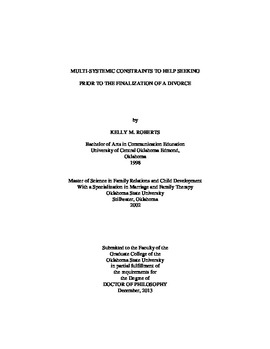| dc.contributor.advisor | Johnson, Christine A. | |
| dc.contributor.author | Roberts, Kelly M. | |
| dc.date.accessioned | 2015-06-17T20:07:42Z | |
| dc.date.available | 2015-06-17T20:07:42Z | |
| dc.date.issued | 2013-12 | |
| dc.identifier.uri | https://hdl.handle.net/11244/15091 | |
| dc.description.abstract | Recent data from Minnesota family courts revealed that approximately ten percent of couples filing for divorce might still be open to reconciliation. This data, coupled with a burgeoning body of literature concluding that children experience better outcomes if raised in two-parent, intact homes, was the impetus for this interdisciplinary study. A literature review covering U.S. divorce law history and policy construction as well as a systems theory framework supported the research goal: To discover multi-systemic constraints to help seeking prior to finalizing a divorce. A grounded theory approach was used to collect data from: 1) a selection of Oklahoma family law statutes specifically covering divorce; 2) focus groups with family court judges in Oklahoma and Tulsa counties; 3) semi-structured interviews with fourteen family law attorneys; and, 4) semi-structured interviews with 39 divorcing persons who had children under the age of 18 and who had filed for divorce but not yet completed the process. A content analysis was conducted on each data set and four major findings were identified: 1) Oklahoma family law statues are written so as to maximize child well-being yet minimize divorcing person well-being or divorcing person opportunities for reconciliation; 2) family court judges believe that opportunities for reconciliation are rare by the time they see a couple in their courtroom, and they are more concerned with the safety and well-being of children or a vulnerable spouse than adding "social work" to their already overloaded duties which includes pressure to close cases; 3) family law attorneys have widely differing views about their professional duty to raise the topic of reconciliation, and they believe that the variance in the opposing practitioner's views or actions negates opportunities to work together toward this goal; and, 4) action and emotion that led to a divorce between marital partners, coupled with a divisive momentum that builds after filing and is propitiated by statutes, attorneys, friends, family members, and/or strains on psychosocial resources (e.g., finances, time, personal energy, or well-being), leave little, if any, possibility for reconciliation. Major and minor themes supporting each finding are provided and potential policy-related solutions are discussed. | |
| dc.format | application/pdf | |
| dc.language | en_US | |
| dc.rights | Copyright is held by the author who has granted the Oklahoma State University Library the non-exclusive right to share this material in its institutional repository. Contact Digital Library Services at lib-dls@okstate.edu or 405-744-9161 for the permission policy on the use, reproduction or distribution of this material. | |
| dc.title | Multi-systemic constraints to help seeking prior to the finalization of a divorce | |
| dc.contributor.committeeMember | Gardner, Brandt C. | |
| dc.contributor.committeeMember | Williams, Sue E. | |
| dc.contributor.committeeMember | Doherty, William J. | |
| dc.contributor.committeeMember | Crethar, Hugh C. | |
| osu.filename | Roberts_okstate_0664D_13053.pdf | |
| osu.accesstype | Open Access | |
| dc.type.genre | Dissertation | |
| dc.type.material | Text | |
| dc.subject.keywords | divorce policy | |
| dc.subject.keywords | family law | |
| dc.subject.keywords | help seeking | |
| dc.subject.keywords | marriage | |
| dc.subject.keywords | marriage policy | |
| dc.subject.keywords | reconciliation | |
| thesis.degree.discipline | Human Development and Family Science | |
| thesis.degree.grantor | Oklahoma State University | |
